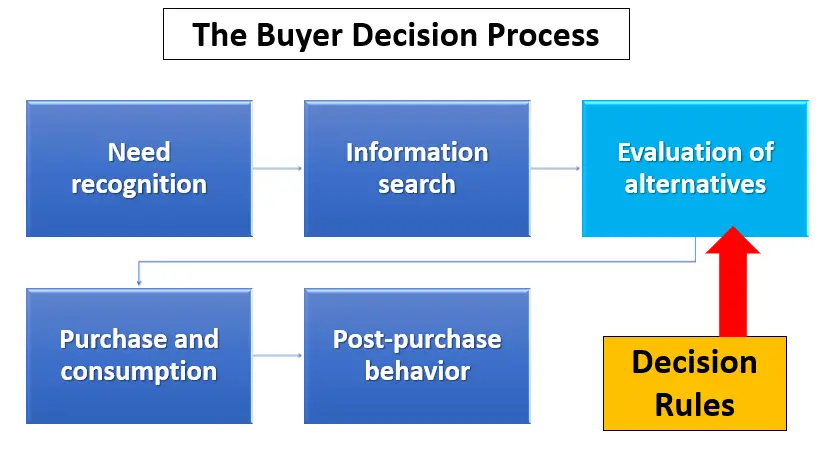What is the Affect Referral Rule in Consumer Behavior?
Covered in this article:
- Overview of the Affect Referral Decision Rule
- Example Statements Made by Consumers Using this Rule
- Why Consumers Would Use the Affect Referral Rule
- How does the Affect Referral Decision Rule differ from other Decision Rules
- The Main Types of Decision Rules Used by Consumers
- Where Decision Rules Fit into Consumer Behavior
- Video Summaries of the Affect Referral Rule and an Overview of all Decision Rules
Overview of the Affect Referral Decision Rule
The affect referral decision rule is considered a non-compensatory approach to decision-making for consumers. However, it is quite unique from the other non-compensatory decision rules in that it does NOT rely upon the evaluation of individual product attributes
Instead of evaluating product attributes, the consumer will “refer” to an overall feeling, emotion, liking, prior experience, or a “rule-of-thumb” approach for their purchase decision.
In comparison to the other decision rules in consumer behavior, each of which rely upon the evaluation of some or all of the product attributes, the affect referral approach is often considered to be a shortcut decision.
A simple way to recall the affect referral rule is to connect the word “affect” to the word “affection” and remember that this is a decision rule based upon feelings, liking, and/or emotions.
Therefore, when using this approach to decision-making, the consumer will refer to their affect (affection = feelings and emotions).
Example Statements Made by a Consumer using the Affect Referral Decision Rule
Probably the best way to further understand the affect referral decision is to use some examples of statements (or thinking) that a consumer might use when initiating this rule. These would include:
- I have bought this brand before, and I have found that their products are always good to use and represent good value
- A friend of mine told me that this brand is a good product and that’s the one I should buy
- I really like the look of this product
- For some reason, I have a feeling that this is the best product for me
- I’ve heard of this brand, so they must be good
- This product has great reviews online, which is something I always look for
As you can see in the consumer statements above, there is no real discussion or consideration of the product attributes or overall consideration of product value.
Instead, a generic and broad statement is made by the consumer to justify their purchase selection.
Sometimes this approach is referred to as “heuristics”. Often in everyday language, heuristics are called a “rule-of-thumb”. That is, they are a mental shortcut that people use to make quick and approximate decisions, often based upon their prior experience or tips that they have heard.
Why would a Consumer Use the Affect Referral Rule
There are multiple situations where the affect referral rule would be appropriate to use for a consumer. These include:
- It is a low-involvement purchase decision, where the consumer is largely disinterested or sees it as a minor no-risk purchase only
- The consumer is overwhelmed by the extent of the information available and cannot easily process a product comparison based upon individual attributes
- It is a product category that the consumer has not purchased before, and as a result, they have a limited understanding of what product attributes that they should be considering in choosing between brands
- This is their normal approach to decision-making that they use when shopping and choosing between products
- The time and effort to do a detailed evaluation and comparison of products based on their attributes is not worthwhile in the consumer’s mind. That is, too much mental effort or time is required versus the risk of making a poor purchase choice.
How does the Affect Referral Decision Rule differ from other Decision Rules
In many ways, this approach to decision-making is quite distinct from the other main consumer decision rules. As you most likely know, the main rules are categorized into either:
- compensatory or
- non-compensatory approaches.
Compensatory decision-making uses an analytical approach, often using scores and points, to construct a considered overall assessment of the product choices.
The word “compensatory” is used in this regard because weak product attributes (in the consumer’s perception) can be offset by strong product attributes. This is because the consumer considers the overall value of the product by taking all key attributes into account.
When using non-compensatory decision-making rules, a consumer will look at selected attributes only. And if any one of those selected product attributes is considered poor by the consumer, then usually that product is usually eliminated from further consideration.
In other words, strong product attributes cannot compensate (that is, make up for) weak attributes when using non-compensatory decision rules.
A Video Summary of the Affect Referral Rule
The following video provides a summary of this decision rule.
The Main Types of Decision Rules Used by Consumers
The main decision rules that are covered in most consumer behavior textbooks are listed as:
- Compensatory decision-making and
- Non-compensatory decision rules, which include:
- conjunctive,
- disjunctive,
- elimination-by-aspects,
- lexicographic, and
- affect referral
The following video provides a brief overview of each of these decision rules.
Where Decision Rules Fit into Consumer Behavior
Decision rules are used by consumers in the evaluation of alternatives stage of the buyer decision process – as shown in the following diagram. At this point in the process, they have gathered information and now must make a selection from competing alternatives.
Related Articles
- What is the compensatory decision rule?
- What is the conjunctive decision rule?
- What is the disjunctive decision rule?
- What is the elimination-by-aspects decision rule?
- What is the lexicographic decision rule?

